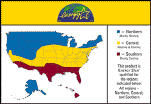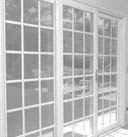Selecting Energy Star®
Windows For Your HomeThe ENERGY STAR®label for residential windows simplifies your purchasing decisions. You can be confident that ENERGY STAR®-labeled windows, doors and skylights exceed the minimum energy efficiency criteria for the climate region in which you live – sometimes by as much as 40 percent! This means that ENERGY STAR®window products will reduce your home energy costs compared to other products.
 The image to the left is the ENERGY STAR®label for windows. This label identifies that the window qualifies for ENERGY STAR®status, and tells you in which regions it qualifies. Windows can qualify in some or all of the northern, central, and southernclimate regions. Additionally, all ENERGY STAR®qualifying windows, doors and skylights will carry another label which indicates that it has been certified by the National Fenestration Rating Council (NFRC). These independent ratings provide the basis for ENERGY STAR®’s window performance requirements.
The image to the left is the ENERGY STAR®label for windows. This label identifies that the window qualifies for ENERGY STAR®status, and tells you in which regions it qualifies. Windows can qualify in some or all of the northern, central, and southernclimate regions. Additionally, all ENERGY STAR®qualifying windows, doors and skylights will carry another label which indicates that it has been certified by the National Fenestration Rating Council (NFRC). These independent ratings provide the basis for ENERGY STAR®’s window performance requirements.
ENERGY STAR®performance requirements are tailored to fit the energy needs of the country’s different climate regions – northern, southern and central states. Additionally, recent technological advancements -- new materials, coatings, design and construction features -- make it possible to choose window products that allow you to balance your winter heating and summer cooling needs without sacrificing versatility or style. Look at the Climate Region Map on the ENERGY STAR® label to be sure that the window, door or skylight you have selected is appropriate for use where you live.
The ENERGY STAR®label identifies efficient windows appropriate for the following three broad climate areas. Click on the climate which you fall under to read how to choose a window that's appropriate for your area:
Buying a Window for the Northern Climate
ENERGY STAR®windows in the northern region must include features to reduce heat loss (windows with a lower U-factor have lower heat loss). The most common way to do this is with a low-e coating, which is a microscopically thin metal coating that is applied to the glass by the manufacturer.
All low-e coated glass products reduce heat loss compared to clear glass products without a low-e coating. Look for a low U-factor on the product’s NFRC label to be sure. Some low-e products also reduce solar heat gains. The percentage of solar heat that is admitted through a window is shown by the solar heat gain coefficient (SHGC) rating. The lower the SHGC rating, the less solar heat the window transmits into your home. If you live in a house that is designed to take advantage of the free solar heating, or you have minimal concern about summer cooling you should look for windows with somewhat higher SHGC ratings.
ENERGY STAR®qualifying windows in the northern climate region must have a U-factor rating of 0.35 or below. Skylights must have a U-factor rating of 0.45 or below.
Buying a Window for the Central Climate
ENERGY STAR®labeled windows in the central region must include features to reduce both heat loss and solar heat gain. The most common way to do this is with a low-e coating.
All low-e coated glass products reduce heat loss compared to clear glass products without a low-e coating. Some low-e products also reduce solar heat gains more than others. The percentage of the solar heat that is admitted through a window is shown by the solar heat gain coefficient (SHGC) rating. All ENERGY STAR® qualifying windows for the central states must have a U-factor rating of 0.40 or below and a SHGC rating of 0.55 or below.
If you live in a home that is designed to take advantage of the free solar heating, or you have minimal concern about summer cooling costs, you can look for windows with somewhat higher SHGC ratings on the NFRC label. If you are concerned about both heating and cooling costs, you may want to look for windows with lower SHGC ratings.
Buying a Window for the Southern Climate
ENERGY STAR®labeled windows in the southern region must include features to reduce the solar heat gain. Two of the most common ways to do this are through tinted glass and low-e coatings. These features limit the amount of solar energy entering your home and reduces the amount of air conditioning needed to keep you comfortable.
All windows, doors and skylights qualifying for the ENERGY STAR®label in the southern region must have a U-factor rating of 0.75 or below and a SHGC (solar heat gain coefficient) rating of 0.40 or below.
Next Feature:
Learn how to install your own windows
